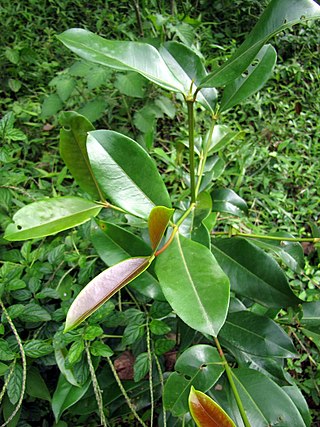
Agathis kinabaluensis is a tree of Borneo in the conifer family Araucariaceae. The specific epithet kinabaluensis is from the Latin, referring to the species being native to Mount Kinabalu in Sabah.
Agathis lenticula is a tree of Borneo in the conifer family Araucariaceae. The specific epithet lenticula is from the Latin meaning "like a double-convex lens", referring to the leaf shape.
Anisophyllea beccariana is a tree of tropical Asia in the family Anisophylleaceae. It is named for the Italian botanist Odoardo Beccari.
Anisophyllea chartacea is a tree of Borneo in the family Anisophylleaceae. The specific epithet chartacea is from the Latin meaning "papery", referring to the leaves.
Anisophyllea corneri is a tree of tropical Asia in the family Anisophylleaceae. It is named for the English botanist Edred John Henry Corner.
Anisophyllea disticha is a plant of tropical Asia in the family Anisophylleaceae. The specific epithet disticha is from the Latin meaning "2-ranked", referring to the leaf arrangement.
Anisophyllea ferruginea is a tree of Borneo in the family Anisophylleaceae. The specific epithet ferruginea is from the Latin meaning "rust-coloured", referring to the leaf hairs.
Anisophyllea impressinervia is a tree of Borneo in the family Anisophylleaceae. The specific epithet impressinervia is from the Latin meaning "sunken veins", referring to the leaf veins.
Canarium fuscocalycinum is a tree of Borneo in the incense tree family Burseraceae. The specific epithet fuscocalycinum is from the Latin meaning "dark calyx".
Canarium littorale is a tree found in tropical Asia and is a member of the incense tree family Burseraceae. The specific epithet littorale is from the Latin meaning "of the seashore", referring to its habitat.
Canarium pseudopimela is a tree of Borneo in the incense tree family Burseraceae. The specific epithet pseudopimela is from the Latin meaning "false pimela", referring to the species' resemblance to Canarium pimela.
Canarium sarawakanum is a tree of Borneo in the incense tree family Burseraceae. The specific epithet sarawakanum is from the Latin, referring to the species being native to Sarawak.

Carallia is a genus of trees in the family Rhizophoraceae.
Canarium grandifolium is a tree in the family Burseraceae. The specific epithet grandifolium is from the Latin meaning 'large leaf'.
Canarium latistipulatum is a tree in the family Burseraceae. The specific epithet latistipulatum means 'wide stipule'.
Dacryodes expansa is a tree in the family Burseraceae. The specific epithet expansa is from the Latin meaning 'spread out', referring to the structure of the petals.
Euonymus castaneifolius is a tree in the family Celastraceae. The specific epithet castaneifolius is from the Latin meaning 'chestnut-coloured leaves'.
Carallia borneensis is a tree of tropical Asia in the family Rhizophoraceae. The specific epithet borneensis is from the Latin, referring to the species being native to Borneo.
Campnosperma squamatum is a tree in the cashew and sumac family Anacardiaceae. The specific epithet squamatum means 'scaly', referring to the leaf surface.
Gluta laxiflora is a tree of Borneo in the cashew and sumac family Anacardiaceae. The specific epithet laxiflora is from the Latin meaning 'loose flowers', referring to the arrangement of the flowers.

